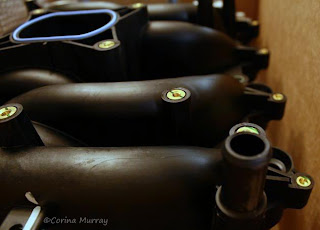A few days after ordering the intake manifold,
it arrived in a beautiful box.
We opened up the box to make sure it arrived in one piece
and to inspect it closely.
As a side-note:
An all metal intake would have been preferable,
however there was a great difference in cost.
The fun part was next.
Removing the current manifold.
Sounds easy, but there are many other
parts that must be removed too.
In the photo above, the upper intake, alternator, fuel rails,
fuel injectors along with hoses,
vacuum lines and other connections
(that all should be labeled) were removed.
The lower intake has been removed,
and now it's extremely evident that labeling
the connections is very important
before removing any part.
This is a close up of the intake ports to show
the grime that has built up over the years,
as well as the old gasket material.
Cleaning all the ports and removing the old
gasket material is the next step.
The shop-vac was also used to remove
anything that might have fallen into the ports.
It looks funny...seeing a vacuum being used
in the engine, but it's effective.
Before I knew it, the new intake was in place.
I had wanted to get a photo of the cleaned up ports,
but my mechanic (husband) was ready to get this
project finished ASAP, and with the Texas heat
taking its toll, I didn't blame him.
Once everything was in place,
we started the car and let it idle to make
sure that there were no leaks, or odd noises.
A test drive was also done to ensure that
all was well, even under pressure.
So, for the past few days, the
Mustang GT has been driven
and no longer occupies the driveway 24/7,
all thanks to my husband for taking on this project :)








